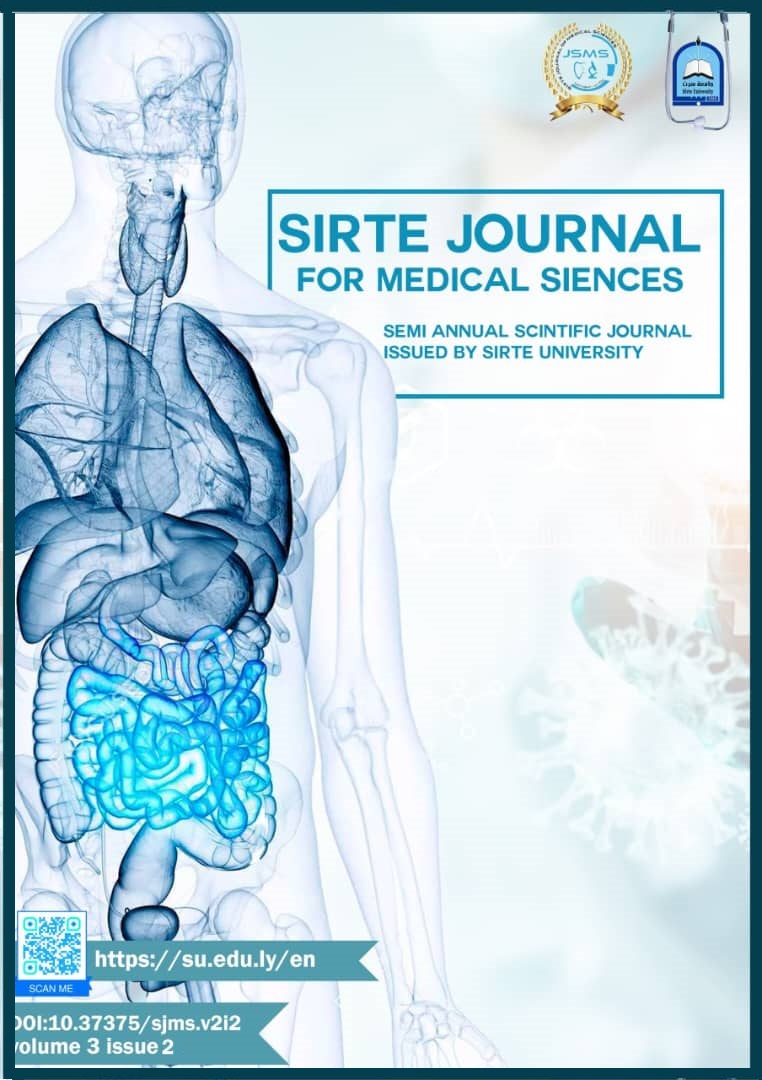Prevalence of intestinal parasites among gastrointestinal patients in Hun City, Libya: A cross-sectional study
DOI:
https://doi.org/10.37375/sjms.v3i2.3169الكلمات المفتاحية:
Intestinal parasites، prevalence, Al-Masra'a Clinic، Libya، , public health، sanitation، , health educationالملخص
Background:This cross-sectional study aimed to assess the prevalence and distribution of intestinal parasites among patients attending Al-Masra'a Clinic in Hun city, Aljufra, Libya,from January 2021 to December 2023..
Methods:A total of 1,079 stool samples were collected from gastrointestinal patients. Sociodemographic data and risk factors were gathered using a structured questionnaire. Stool samples were examined using light and dark ground microscopy, direct smear techniques with normal saline and Lugol’s iodine, and the formalin-ether concentration technique. Ziehl-Nielsen staining was used for microscopic differentiation of parasite developmental forms. Data were analysed using SPSS (version 24), with descriptive statistics and Chi-square tests employed to identify significant associations.
Results:Intestinal parasites were detected in 13.3% (144/1,079) of the patients, with a significant difference (P=0.02). Males had a higher infection rate (68.75%) compared to females (31.25%), with a significant difference (P=0.04). The highest prevalence was observed in individuals under 20 years (48.6%), followed by the 20-40 age group (22.2%). Entamoeba histolytica was the most common parasite (73.61%), followed by Giardia lamblia (10.41%) and Entamoeba coli (7.63%). Co-infections were rare (6.25%). The prevalence of infections declined over the study period, from (11.6%) in 2021 to (7.4%) in 2023 (P=0.02). Rural areas had a significantly higher prevalence (84.02%) compared to urban areas (15.97%), with a significant difference (P=0.04).
Conclusion:The study highlights the need for targeted public health interventions, particularly in rural areas, to improve sanitation, health education, and access to healthcare. Enhanced water quality and hygiene practices are crucial to reducing the burden of intestinal parasitic infections in the region.
المراجع
- 1.Ali, A. M., & El-Khalil, M. A. (2021): Prevalence of Intestinal Parasites among Children in Libya. Libyan Journal of Medical Sciences, 5(2), 45-52.
- 2.Alqeer Aliyo and Tibeso Gemechu (2022): Assessment of intestinal parasites and associated factors among HIV/AIDS patients on antiretroviral therapy at Bule Hora General Hospital, West Guji, Ethiopia. Epidemiology of Infectious Diseases - Original Research Article. Volume 10: 1–7. sagepub.com/journals-permissions. DOI: 10.1177/20503121221124685. journals. sagepub.com /home/smo.
- 3.Bashir, N., Ali, A., & Ali, A. (2020): Drug resistance in intestinal parasites: A global perspective. Infectious Diseases of Poverty, 9(1), 1-8.
- 4.Crompton, D. W. T. (2001): How much human time is spent on a hookworm infection? Parasitology Today, 17(6), 291-295.
- 5.Ebrahim, A., El-Hamshary, A., & Mahmud, S. (2022): Giardiasis in southern Libya: Epidemiological insights and public health implications. African Journal of Medical Sciences.
- 6.El-Kaoua, M., Younis, A., & Amran, S. (2019): Patterns of intestinal parasite co-infections in Benghazi, Libya. Mediterranean Health Journal.
- 7.El-Sherbini, G. T., & Ghenghesh, K. S. (2020): Prevalence of intestinal parasites among patients in Tripoli, Libya. Journal of Parasitology Research.
- 8.Ghanem, A. A. M., & El-Baghdadi, H. A. (2022): Intestinal Parasites in Adult Patients: A Study from Libya. African Journal of Infectious Diseases, 16(1), 12-18.
- 9.Hassanein, A. S., & Zaid, A. A. (2020): Impact of Intestinal Parasites on Public Health in Libya. Journal of Parasitology Research, 2020, Article ID 123456.
- 10.Hassanein, M., & Zaid, F. (2020): Impact of Sanitation on Intestinal Parasite Prevalence in Libya. International Journal of Epidemiology, 48(4), 1123-1129.
- 11.Khalil, M., et al. (2018): Intestinal parasitic infections in patients with inflammatory bowel disease: A systematic review. Journal of Crohn's and Colitis, 12(5), 605-615.
- 12.Mansour, F. E., & Al-Sharif, A. A. (2023): Comparative Study of Intestinal Parasites in Urban and Rural Areas of Libya. Libyan Journal of Science and Technology, 10(1), 30-36.
- 13.Michaud, A., et al. (2020): The impact of intestinal parasites on gastrointestinal diseases: A review. Clinical Microbiology Reviews, 33(2), e00032-19.
- 14.Nour, M. A., et al. (2021): Co-infections of intestinal parasites in patients with gastrointestinal symptoms: A study from a tertiary care hospital. BMC Infectious Diseases, 21(1), 1-10.
- 15.Salem, M. H., & Ibrahim, M. A. (2021): Health Awareness and Its Impact on the Prevalence of Intestinal Parasites in Libya. Journal of Community Health, 46(4), 789-795.
- 16. World Health Organization. (2022): Preventive chemotherapy to control soil-transmitted helminths infections in at-risk population groups. Geneva:World Health Organization.











